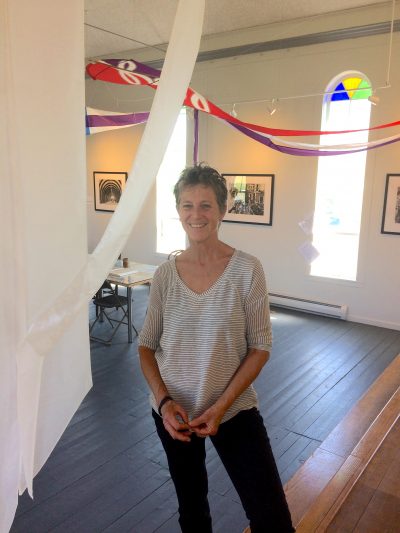Art That Enlivens and Enlightens: A Portrait of GreenTARA Space

By Olivia J. Kiers
“When I first saw this space, it was all junked up,” said Diane Gayer, gesturing around herself inside the one-year-old GreenTARA Space on North Hero, a small community on Grand Isle in Vermont’s Lake Champlain. “But I could feel the space, and that’s what I was after… All I did was to unveil it.”
Gayer, an architect with a background in community planning in Vermont, had been longing to convert an abandoned building into an art gallery when she found North Hero’s former Catholic church and decided to pursue her dream there. “A lot of the locals went to church here,” she explains, pointing out architectural details like narrow supporting columns, and stained glass at the tops of tall windows. “The feedback has been really good. They feel like the church is back. They can feel it has opened up to them again.”
Ways in which GreenTARA has opened to the community goes beyond art. The gallery offers a coffee counter and comfortable seating, and during the summer it hosts movie nights. Chocolatiers rent space downstairs—“just another kind of art,” Gayer says. And it serves more than just locals. A mere 20 minutes from the border, GreenTARA attracts visiting Canadians. “For them, we are not the end of the road. We are the opening.”
GreenTARA’s mission goes beyond trendy repurposing and attracting the Canadian market, however. “Green Tara is the Tibetan goddess of enlightened activity,” Gayer explains. “The name choice goes back to this: how do you make a building become a prayer to the world and help heal whatever is going on that needs healing?” With an eye to restoring degraded land surrounding the church, she planted herbs and blueberries. A green roof was installed over one side entrance. And as for the art, Gayer purposely selects contemporary works that confound expectations of “typical island art.”
“I’m happy to play with What’s the meaning of art? Why is it that we only think of art as stuff that’s framed and on a wall? … It can be a very abstract concept for some people to see the work I show as art.” For example, Gayer recalls her first season, when she held an exhibition of “boat art” by pairing an historic river boat and replica built by UVM undergraduates with two large, abstract panels that artist Mary Zompetti created by scanning kelp, sand and water. “I play a lot with how two pieces can talk to one another.”

For the first exhibition of 2018 in May (the gallery is seasonal, open this year through early October), GreenTARA displayed Spirit of Place, which featured Nori Pepe’s linocut prints and kites created by Kate Pond. During ANE’s visit, Pond’s kites hung from the ceiling, bold streaks of purple, red and white lifting and dipping overhead as if they were actually being flown outdoors. Messages stitched across their long tails were simple yet unusual. Help one read, while another said Défense d’Afficher—referencing a French law against posting flyers in some public spaces. Meanwhile, Pepe’s black and white linocuts detailed intricate cityscapes, each of which took a year to complete. One print depicted a large crowd waiting for a train in Moscow; another showed rooflines on the Amalfi coast. Pepe and Pond’s focus mixed with lyricism created an overwhelming impression of the artists’ indefatigable sense of curiosity, and of Gayer’s willingness to think outside the box.
In many ways, GreenTARA reflects a strong sense of Gayer’s vision. Yet perfectly planned as it all seems, Gayer claims there was never a detailed roadmap to success in place—intentionally. “I work with my intuition. In my industry, it’s called ‘design build.’ Of course I waited for a long time before doing this, but none of it’s planned. It’s all happening as it happens, being informed by the space, the materials, the place… The delight I get is in seeing what has happened by the end of the season. Will I still be here, doing this in a couple of years? In 20 years? I don’t know.”
Whatever the future may hold, Gayer hopes that the art and space have a positive impact in North Hero today, that it “energizes us all to do good.” She smiles. “Art does that. Art helps us see beyond… I renovated the building to make it come back alive, and I’ve chosen to showcase art that speaks to that in some way.”
